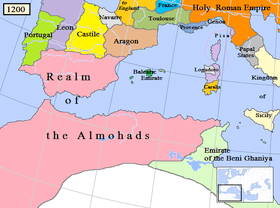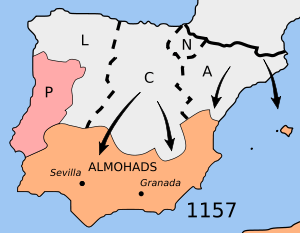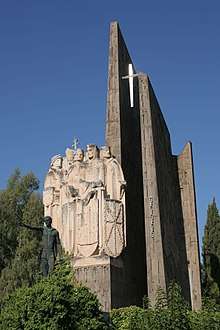Almohad reforms
The Almohad reforms were a series of changes to the existing religious climate in Islamic Spain over the course of seventy years.[1][2] The preceding Almoravid dynasty, while more repressive than some governments in Al-Andalus, was not violent. The religious fundamentalism of the Almohad Caliphate caused a massive emigration of Jews and Christians from southern Iberia to the Christian north and North Africa, specifically Egypt.

Origins
Religious climate before Almohads
During its golden age, Spain was open to a good deal of religious tolerance. For the most part the Almoravids let other People of the Book, or other religions that held the Old Testament as a holy text, practice their religion freely.[3] The Almoravids, however, were more puritanical than previous Muslim rulers of Spain.
The golden age for Jews in Spain is considered to be under the relative lax rule of the Muslim Caliphates in al-Andalus. It was generally a time when Jews were free to conduct business, participate in government, and practice their religion without fear of persecution.
Rise to power

Like the Almoravids, the Almohads crossed over into Spain from North Africa. They were led by ibn Tumart, regarded by historians as a fundamentalist who was convinced that it was his destiny to reform Islam. He was an intelligent and charismatic man; he claimed to be a direct descendant of Muhammad. He had studied in Alexandria, Córdoba, Mecca, and Baghdad,[3] and his fanaticism and charismatic preaching earned him a devoted group of followers.
He presented a different view that caused outright hostility on the Iberian peninsula.[4] To top off the Almohads' meteoric rise, in 1146 they crossed over the Strait of Gibraltar into Iberia.[5] Their rule quickly spread across a new continent. At their height they were one of the most powerful forces in the world. Once they took control over the Iberian Peninsula, they cemented their presence by moving their capital from the high Atlas village of Tinmel to the Spanish city of Seville. They were a determined military and economic force, defeating Christian forces primarily composed of Castilians at the Battle of Alarcos.[6] This marked the height of the Almohad Caliphate.
Reforms
At their peak in the 1170s, the Almohads had firm control over most of Islamic Spain, and were not threatened by the Christian forces to the north.[6] Once the Almohads took control of southern Spain and Portugal, they introduced a number of very strict religious laws. Even before they took complete control in the 1170s, they had begun removing non Muslims from positions of power.[7]
Jews and Christians were denied freedom of religion, with conversion or death being the rule. This type of behavior was utterly unprecedented in previous Muslim caliphates. However, the Almohads were on a self declared Jihad, and they were willing to use brutal techniques to back up their holy war.[8] When the Almohads took control, many Jews were killed in the invasion. Believing they were on a divine mission, the overall philosophic goal of the Almohads was to turn Jews into Muslims.[7]

Half-hearted oaths were certainly not looked to as ideal, and this brought a lot of problems for the population of Spain. The Almohads recognized that many of the conversions by Jews were not particularly sincere, which certainly did not help promote unity.[7]
They responded to this by imposing severe regulations on the business of former Jews. One ruler, Abu Yusuf Yaqub al-Mansur, set up a strict dress code for Jews living within Almohad territory. Jews had to wear dark blue or black, the traditional colors of mourning in Islam. The discrimination became unbearable for many living under the Almohads.[9]
Philosophy
The Almohad judicial system has been described as looking to the letter of the law rather than the deeper intended purpose of the law. They adhered to the Zahirite school of law within Sunni Islam; under the reign of Abu Yaqub Yusuf, chief judge Ibn Maḍāʾ oversaw the banning of any religious material written by non-Zahirites.[10] Abu Yaqub's son Abu Yusuf went even further, actually burning non-Zahirite religious works instead of merely banning them.[11] They trained new judges, who were given schooling in both the religious and military arts.[4]
They had a very traditional philosophy, one which did not look to any of the reforms past caliphates had attempted to institute. Where the preceding Almoravids considered themselves an empire, the Almohads sought to return Spain to the days of the Caliphate.[12]
Decline
The Almohad caliphate was decisively defeated by the combined Christian forces of Portugal, Castile, and Aragon at the Battle of Las Navas de Tolosa, in 1212.[13]
The battle is recognized as one of the most important events in the reconquista movement in Spain. Not only was it a decisive defeat of the Muslim forces, it was also one of the first times the fractured Christian kingdoms of the north came together for the common goal of reclaiming the peninsula. By 1270, the Almohads were no longer a force of any significance on the Iberian Peninsula, or anywhere else in the world. After their fall, the fundamentalist religious doctrine that they supported was relaxed once again. One holdover for Jews was a law that stated that people who converted to Islam would be put to death if they reconverted.[14]
Works cited
- Pascal Buresi and Hicham El Aallaoui, Governing the Empire: Provincial Administration in the Almohad Caliphate 1224-1269, pg. 170. Volume 3 of Studies in the History and Society of the Maghrib. Leiden: Brill Publishers, 2012. ISBN 9789004233331
- Dominique Urvoy, The Ulama of al-Andalus, pg. 868. Taken from The Legacy of Muslim Spain, Volume 12 of Handbook of Oriental Studies : The Near and Middle East. Eds. Salma Khadra Jayyusi and Manuela Marín. Leiden: Brill Publishers, 1992. ISBN 9789004095991
- Allen Fromherz, "North Africa and the Twelfth-century Renaissance: Christian Europe and the Almohad Islamic Empire", Islam & Christian-Muslim Relations 20, no. 1 (January 2009): 43-59.
- Madeleine Fletcher, "The Almohad Tawhīd: Theology Which Relies on Logic", Numen, v. 38, no. 1 (June 1, 1991): 110-127
- Amira Bennison, "The Almohads and the Qur'ān of Uthm ān: The Legacy of the Umayyads of Cordoba in the Twelfth Century Maghrib", Al-Masaq: Islam & the Medieval Mediterranean 19, no. 2 (2007): 131-154.
- J. F. Powers, "The Early Reconquest Episcopate at Cuenca, 1177–1284", The Catholic Historical Review, v. 87, no. 1 (2001): 1-16.
- Norman Roth, "The Jews and the Muslim Conquest of Spain", Jewish Social Studies 38, no. 2 (Spring 1976): 145-158.
- Maribel Fierro, "Decapitation of Christians and Muslims in the Medieval Iberian Peninsula: Narratives, Images, Contemporary Perceptions", Comparative Literature Studies, v. 45, no. 2 (2008): 137-164.
- Comparative Literature Studies, "The Decline of the Almohads: Reflections on the Viability of Religious Movements", History of Religions, v. 4, no. 1 (July 1, 1964): 23-29.
- Kees Versteegh, The Arabic Linguistic Tradition, pg. 142. Part of Landmarks in Linguistic Thought series, vol. 3. New York: Routledge, 1997. ISBN 9780415157575
- Shawqi Daif, Introduction to Ibn Mada's Refutation of the Grammarians, pg. 6. Cairo, 1947.
- Maribel Fierro, "Alfonso X 'The Wise': The Last Almohad Caliph?", Medieval Encounters 15, no. 2-4 (December 2009): 175-198.
- Isabel O’Connor, "The Fall of the Almohad Empire in the Eyes of Modern Spanish Historians", Islam & Christian-Muslim Relations 14, no. 2 (April 2003): 145
- Amira Bennison, "The Almohads and the Qur’ān of Uthm ān: The Legacy of the Umayyads of Cordoba in the Twelfth Century Maghrib", Al-Masaq: Islam & the Medieval Mediterranean 19, no. 2 (2007): 131-154.